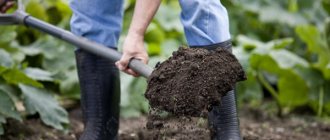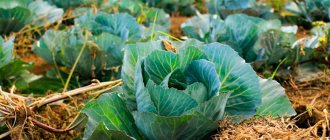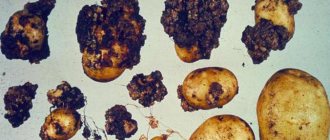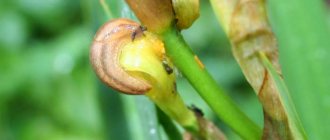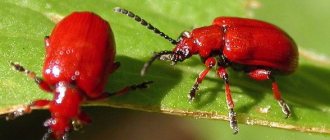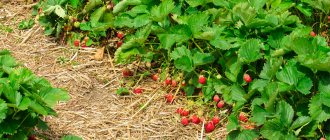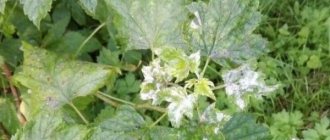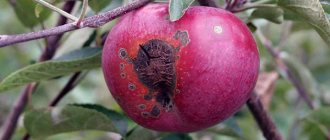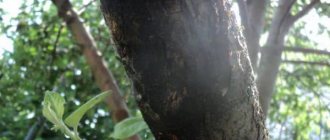Description of the pest
Nematodes are one of the most dangerous potato pests. This is a microscopic roundworm 0.6-1 mm long. It can live on the roots, tubers and stems of the plant. The female's body is round in shape and smaller in size than that of the male. In summer it is white, by autumn it acquires a golden-brown or brown tint.
Photo of potato nematode. Taken from wikimedia.com
The male lives for 1.5 weeks and dies after fertilization of the female. Females accumulate up to 800 eggs in their bodies. In the fall they die and turn into cysts in which eggs are stored. Under favorable conditions, egg capsules can be stored for up to 10 years.
Description of the parasite
These are small worms measuring 0.3 - 1.3 mm. They feed on the sap of plants that belong to the Solanaceae genus. The peculiarity of nematodes is that sexually mature individuals are able to enter the cyst stage. Inside the cyst there are about 200 eggs, which then develop into larvae and new individuals. The cyst tolerates any adverse weather conditions: drought, flood, frost.
You can notice the damage by seeing worms on tubers and roots. At the beginning of development, the lower leaves of the potato turn yellow, the tops dry out, it develops poorly, the tubers are small and loose. On tubers, the parasite is located in the form of golden or white small bubbles. It is tightly attached to root vegetables. Since at the end of the season the potato nematode goes into the cyst stage, it is difficult to fight it. If you can get rid of it for one season, then the next year the infection will recur.
Important! When potatoes are infected with nematodes, up to 80% of the crop is lost; control methods must be adopted.
Types of nematodes
There are several types of pests, the most common in our country is the golden nematode.
Potato golden nematode
This type of nematode damages the roots of the plant, which become too branched.
Nutrients do not circulate well, and as a result, the lower leaves of the bush begin to dry out. The tubers are small or not formed at all.
Stem nematode
The pest attacks potato stems and tubers.
Dark spots appear on the skin of the tubers. The pulp becomes loose or turns into dust.
Root-knot nematode
This type of nematode destroys the roots and tubers of the plant.
Growths or galls up to 3 cm thick form on the roots. Potato tubers become lumpy. The pest also affects pumpkin crops.
Pallid nematode
On plantations affected by the nematode, rare, painful stems are formed.
There are no more than three of them, they turn yellow prematurely. The tubers are formed very small or not formed at all.
Signs of a pest
The first signs of parasite damage appear on days 45–50 of the vegetative period. Infected bushes differ in the following characteristics:
- slow growth of green mass of the bush;
- yellowing of the lower leaves;
- drying of the tops before the harvest time;
- leaf curling;
- uneven stem shape;
- small fruits;
- roots turn brown;
- lack of flowering;
- the appearance of small white or yellow balls on the tubers;
- loose structure of the root crop;
- black spots on tubers.
Control of potato nematode
Pest control is complicated by the fact that it is difficult to immediately notice it on potatoes. Gardeners use different means.
Chemicals against nematodes
Chemicals are used when absolutely necessary because they are toxic.
The most commonly used means of contact action are:
- Lindan,
- Karbofos,
- Phosphamide.
It must be remembered that for greater effect, chemicals are combined with biological and agrotechnical means.
Folk remedies
Before planting potatoes, spray the infusion of sprouts from the tubers. This will lure the larvae out of the cyst, and they will die from lack of food.
Along the perimeter of the potato plot, plant plants that repel parasites:
- marigold,
- beans,
- calendula.
Biological products
Biological preparations have a narrowly targeted effect and act directly on the pest. These include: Basamil, Metarizin.
Agrotechnical methods
When planting potatoes, add the following to each hole:
- manure,
- chicken droppings,
- ash.
You can use mineral fertilizers containing:
- nitrogen,
- potassium,
- copper,
- phosphorus,
- cobalt
- and manganese.
Enriching the soil with minerals will prevent the development of nematodes.
Fighting methods
If you suspect the appearance of a dangerous parasite on your site, you must inform the regulatory authorities (phytocontrol specialists) about it. Based on the results of the examination, the types of pests will be determined and measures will be developed to exterminate the quarantine parasite. There are no effective ways to completely destroy the pest, and only comprehensive control measures will help cope with this scourge.
Folk remedies for potato nematode
How to fight the parasite? The arsenal of remedies is small, since no decoctions, infusions, or herbal solutions have any effect on the nematode. Partly, planting plants with a strong aroma next to potatoes can help: tagetes, calendula, fennel.
Thermal disinfection of the soil is also carried out, for which the beds are spilled with boiling water before planting the tubers. Conditions:
- the water temperature should be between 60-70 degrees;
- Soil layers should be soaked to a depth of 20-25 cm.
The procedure is labor-intensive and only possible in small areas. In this case, only part of the worms in the upper layers of the soil dies, and the cysts remain unharmed.
Use of chemicals
Traditional pesticides, with which gardeners and farmers successfully fight potato pests, are not suitable for exterminating this type of worm.
Causes:
- natural resistance of nematodes to pesticides;
- features of the biological development of worms of this type;
- the presence of cyst-forming species, which complicates the fight;
- little knowledge of the pest.
Nematicide preparations have been developed specifically for the destruction of herbivorous roundworms. They are classified according to the mechanism of action on parasites:
- fumigants (cause the death of worms when they enter the body in a gaseous or vaporous state);
- contact preparations (direct effect on the skin of nematodes);
- systemic (absorbed by the leaves or root system of plants, destroying nematodes when feeding).
Application depends on the type of nematodes, soil type, and potato growing conditions. Effective fumigants include Nemagon, Carbation, and Chloropicrin. They are added to the soil and also used for dressing tubers.
On a note!
Chloropicrin is a complex-action nematicide that leads to soil sterilization. Planting tubers with this treatment is allowed no earlier than two months later.
Among the contact drugs that destroy the nematode, the following are used:
- Phosfamide;
- Lindan;
- Karbofos;
- Methyl mercaptophos.
Systemic agent – Dimethoate. All drugs are toxic and are considered potent poisons, so use is permitted only in strict compliance with the instructions and safety regulations.
Use of biological drugs
To exterminate nematodes, some biological preparations of the nematicide group are used. Among them:
- Basamil,
- Metarizin,
- Narcissus,
- Nematophagin BT,
- Phytohit.
Unlike chemicals, biological compounds are safe, but their action is narrowly targeted and does not always give results.
Agrotechnical methods
When growing potatoes, it is important to provide the crop with adequate nutrition and create conditions for comfortable growth and development of plants.
For this:
- carefully prepare the site in the fall, applying fertilizers and removing weeds;
- Green manure crops are sown to cultivate and disinfect the soil: rye, calendula, tagetes (marigolds);
- water the plantings with bird droppings (1:20 solution), which is detrimental to the parasite larvae;
- When planting tubers, a handful of ash and onion peels are placed in the hole, the smell of which is not tolerated by nematodes.
It is important to select pest-resistant varieties, taking into account the climate of the area and soil characteristics.
Preventive measures
Potato nematode does not respond well to various drugs; preventive measures are more effective:
- Competent crop rotation. Potatoes cannot be planted in the same area every year. Do this once every 3-4 years.
- Sow mustard, rye, legumes, marigolds, and calendula on the affected area. Excretion from their roots is destructive for the pest, but for the soil it is an excellent means of replenishing lost elements. Useful information: Green manure what is it Mustard as green manure Spring vetch - fertilizer for the garden
- Use urea. In autumn and spring, add the drug to the soil; the nematode does not tolerate this product. Learn how to use urea as fertilizer.
- Use healthy tubers. Before planting in the ground, they need to be treated with potassium permanganate.
- Increase soil fertility. There will be more earthworms, and they are the enemies of the nematode.
- Use nematode-resistant potato varieties. But after 3-4 years they need to be replaced with regular ones, as the pest quickly adapts.
- Burn the tops of diseased plants.
What kind of beast
Nematodes are a type of roundworm. One female can give birth to up to 250 new individuals; 10 generations can change in a year. Nematodes are native to South America. Eggs can survive frosts, floods, radiation, and droughts.
The worms themselves are very small, but can destroy up to 80% of the potato crop. The size of the worm is up to 1.63 mm. The most favorable temperatures for nematode reproduction are 20 to 24 degrees above zero. Potato species are respected not only by people, but also by worms. The most common types of nematodes on potatoes are:
Since it is a polyphage, it affects not only potatoes, but the following plant species:
Potatoes are damaged during the growing season and also live in storage on tubers. It feels most comfortable in damp basements and generally in damp environments. They can be identified by small white spots with a hole in the center. They are found under the skin. The affected area can be found when palpating the tubers - it becomes soft.
Then the tissues become brown, the skin above them cracks, and the flesh crumbles. Worms, larvae, and nematode eggs can be found in diseased tissues. Potatoes rot and wrinkle over time, and are subsequently destroyed by bacteria and fungi.
Golden
The most common type of nematode in Russia. They penetrate the roots and feed on potato juices, preventing beneficial substances from reaching other parts of the potato. The affected plant dries quickly. The process starts from the leaves at the bottom. Tubers are either absent or very small, but the root system is very branched. The female turns into a cyst in the fall, which can contain about 8 thousand eggs. Such a cyst can be viable for up to ten years. Larvae can hatch from it at different times.
It differs from the previous one only in color. Females turn brown over time.
The pest can be identified by its lumpy tubers. Also, bumps can form on the roots. This nematode prevents water and nutrients from reaching the stems.
Remedies and preparations: how to get rid of them?
There are many systemic and contact poisoning agents that are sprayed on plants. Solutions of mercaptophos, lindane, as well as methyl bromide, chloropicrin, carbathion and organophosphorus compounds are very popular. Systemic drugs enter the plant through the root system, and poison nematodes with leaves and stems. Spraying of plant bushes or fruit trees with organophosphorus compounds (phosphamide, karbofos, methyl mercaptophos) is carried out to remove leaf and stem nematodes. To completely get rid of adults, carry out 3-4 plant treatments per week.
What to process:
- Phosfamide is a moderately hazardous substance for humans and animals, but quite toxic to pollinating insects. The product is effective in the fight against garden mites and aphids, as well as roundworms. Spraying of fruit trees (pears, apple trees) is carried out with a 0.1% or 0.2% solution at the rate of 0.8-4.0 kg per 1 hectare; for cherries and plums 0.8-3.0 kg will be required. Treatment is stopped a month before harvest. Experts do not recommend spraying near greens, vegetables and berries;
- Environmentally friendly and safe BAC "Ecogel" helps protect plants from all kinds of diseases, including root-knot nematodes. The product applied to the soil has a detrimental effect on eggs and adult nematodes. The protective effect lasts from 3 to 9 weeks;
- The basis of the drug “Nematophagin BT” is carnivorous fungi. Application consists of introducing it into the ground to a depth of 15 to 20 centimeters. Unlike chemicals, it is completely safe, and fungal mycelia cause the death of nematodes within 24 hours;
- The drug “Fitoverm” helps fight roundworms. Its release form is 0.2% powder. Acting on parasites and their larvae, it prevents them from feeding normally. Apply into the soil directly under infected plants.
Compliance with all recommendations for sanitary preparation and soil fertilization, constant thermal treatment of soil, roots and seeds will help protect the crop from the spread of nematodes. For planting, choose plants that have high immunity; plant repellent plants nearby to repel roundworms.
Sources:
https://sornyakov.net/vegetables/steblevaya-nematoda-kartofelya.html https://moefermerstvo.ru/kartofel/nematoda-kak-borotsya https://web-selo.ru/nematoda-kartofelya.html
Potato varieties resistant to nematodes
The most popular nematode-resistant varieties are:
- dolphin;
- Belorussian;
- Zhukovsky;
- caratope;
- Lukyanovsky;
- frigate;
- primary forest;
- Latona;
- fresco;
- prior
These varieties are the most resistant to nematodes. By growing these types of potatoes, you can get rid of the parasite. Since they will not be able to feed on the tubers of these varieties, the worms will slowly begin to leave the area and die. This variety is planted for 4 years in a row, then replaced with another.
How to get rid of nematodes on potatoes?
It is often not possible to completely defeat a nematode on an area, but it is within your power to significantly reduce the number of this pest and reduce the number of nematodes on an area to a minimum.
Chemical control agents
To effectively combat nematodes, it is appropriate to use insecticides from the group of nematicides .
1. It is quite possible to use drugs from the contact group, such as
- Karbofos,
- Lindan,
- Phosphamide.
2. It is permissible to use fumigants that, in the form of gas, penetrate the pest’s body and kill it; these are drugs:
- Chloropicrin,
- Nemagon,
- Carbation.
Biological products
It is quite acceptable to use biological preparations to combat nematodes, but their effectiveness is not very high and if the soil and plants are heavily infested with nematodes, they can be said to be ineffective.
These are biological products:
- Metarizin,
- Basamil.
Folk remedies
Using various kinds of infusions and decoctions to combat nematodes is not effective, you will simply waste your time and energy, they will not be of any use or will be of very little use. In this case, biological preparations will be much more effective than folk remedies based on decoctions and infusions, and there will be no harm to the environment from biological preparations as well as from infusions and decoctions.
Watering with boiling water
Of the folk control measures, perhaps the most effective would be to use boiling water to scald the soil.
- The hottest boiling water is used for this.
- The soil must be loosened and generously watered with boiling water.
- It is advisable to repeat the procedure several times in order to disinfect the soil as much as possible and to the greatest possible depth.
It is clear that it is appropriate to treat the soil by pouring boiling water over it in small areas. But on large areas, from 10 acres or more, it is more appropriate to use chemicals.
Marigold
There is also an opinion that the smell of marigolds repels the potato nematode; whether this is true or not is difficult to say, but there is nothing easier than sowing marigolds around the perimeter of a plot with potatoes - it’s beautiful, and there is a chance that the nematode will not appear or will leave your plot.
How dangerous is a nematode?
The nematode actively attacks the root system of potatoes, stolons, and tubers. Able to penetrate stems without much difficulty.
- Potato plants begin to lag in growth, produce minimal yield, and die if heavily infested.
- Tubers affected by nematodes usually begin to rot. Such tubers are not eaten as food, and it is useless to store them.
- In addition, even if the nematode has only slightly affected the plant, it often carries a viral infection. And if the physical damage is small, then the viruses carried by the nematode will do their job and still destroy the plant.
| The potato nematode can cause you to lose no less yield, and sometimes even more, than the Colorado potato beetle. Crop losses often exceed 50% and reach 80%. |
The danger for plants is maximum, because sometimes it is not possible to completely defeat the nematode; they are quite resistant to various insecticides. Nematodes parasitize mostly in that part of the plant that is located under the surface of the soil, and this greatly complicates treatment and complicates the detection and identification of the pest.
| IMPORTANT Nematode does not pose a danger to humans |
Potato nematode
Description. The golden potato nematode is the object of external and internal quarantine of the Russian Federation. Foci of potato nematode are more often found in depressions in the field. In Russia, in addition to potatoes, the nematode only infects tomatoes. The lower threshold of harmfulness, depending on growing conditions, ranges from 5 to 10 cysts per 100 grams of soil (or 2-5 infective larvae/g of soil). During the growing season, only one generation of the parasite develops. In perennial foci of infection, 2-3 weeks after planting potatoes, the population density of invasive larvae can reach 100 million individuals per 1 m2 to a depth of 40 cm. In the absence of host plants, cysts with invasive larvae remain in the soil for up to 8-9 years. The nematode has several trophic races adapted to feeding on different plants and potato varieties. The spread of the pest is carried out with planting material, with the flow of melt water (due to which many cysts accumulate in depressions and, as a result, frequent plant losses), on contaminated agricultural equipment, with wind currents (in arid regions).
Signs of damage. The nematode is widespread in private farms (or garden plots). Infection in the field, as a rule, is focal in nature. The main symptom is stunted growth of affected plants; outwardly they look wilted and chlorotic, and are stunted in growth (sometimes lunges are observed). Soon after infection, potato bushes begin to lose their lower leaves. Flowering in the foci is usually absent or very sparse. Even with a small number of nematodes, severe suppression of the affected plants is observed. The pathology is enhanced by a high dose of digestive enzymes secreted by the nematode, as well as their derivatives circulating in the conducting system. They suppress the normal growth of the aboveground part of the plant. Tubers are formed small and in small quantities.
Potato plant affected by nematode.
Appearance. Female nematodes are spherical with a short head protrusion and dimensions: 0.41-1.12 x 0.31-0.99 mm. Young females are white, with age they become golden yellow, then cysts, brown or dark brown. In the soil in the spring after the snow melts and before planting, only dark brown cysts filled with a large number of eggs and infective larvae are found.
Males are worm-shaped, 0.91-1.23 mm long; stylet 27-28 microns. The cuticle is ringed, the tail is short, with a rounded tip. Infective larvae of the 2nd instar, 0.32-0.57 mm long; the healine (transparent) part of the tail is approximately equal to the length of the stylet.
The larvae are of a typical worm-like shape, rolled up in eggs, newly hatched larvae have a length of 0.35 - 0.52 mm with a width of 0.018 - 0.025 mm, transparent
Life cycle . The nematode overwinters as a larvae in an egg shell inside a brown cyst, which is the shell of an old female. One cyst contains from several tens to one thousand eggs and larvae. The temperature threshold for development at which the larvae begin to penetrate the root at a temperature of 10...12°C. In the optimal temperature range (from 17 to 24°C), the development cycle takes place in 38-48 days. In the spring, under the influence of root secretions, the infective larvae leave the cyst and enter the soil. The emergence of larvae from cysts occurs gradually and takes up to 2 months; They first infect the roots and then young potato tubers. The ripening female breaks through the epidermis of the root and turns into a cyst filled with eggs and larvae. Epiphytoty, as a rule, develops in patches. In such outbreaks, heavily infected plants develop slowly; after seedlings emerge from the soil surface, they quickly lose their lower leaves; such plants usually do not flower. Affected roots do not have any external symptoms of the disease. Only upon careful examination are white or brown female nematodes located on the surface visible on the roots. In this case, the head end of the female is immersed in the central cylinder of the root.
Distribution and harmfulness . According to the quarantine service, as of 2004, the nematode was registered in 56 regions and territories of the Russian Federation on an area of more than 53,000 hectares. The harmfulness of potato nematode depends on a number of factors. In general, on sandy and poorly fertilized soils it is higher than on cohesive soils rich in humus. In some cases, losses from nematodes can be more than 40%
Factors contributing to the development of nematodes
- The optimal development temperature is from 17 to 24°C.
Ways to fight:
- The main and most effective method of control is a 4-5-field crop rotation.
- Use (preferably) globoderosis-resistant potato varieties.
- Destruction of post-harvest residues and infected tubers and roots.
- Cleaning and disinfection of agricultural equipment
- Application of chemicals against nematodes
Chemical means of controlling nematodes on potatoes.
- The main way to combat the golden nematode is the use of nematicide Vidat 5G. The drug is applied to the row together with planting or in a continuous manner, followed by incorporation before planting. Once in the soil, the nematicide gradually releases the active substance, causing disorientation of the nematodes and preventing their movement towards the roots of the plant. The active ingredient oxamyl penetrates well and actively moves in the roots and shoots of plants after application and protects them from the penetration of nematodes. At the moment, Vidat is the only registered drug against nematodes.
Sources
- Protection of potatoes from pests, diseases and weeds / B.V. Anisimov, G.L. Belov, Yu.A. Varitsev, etc. - M.: Kartofelevod, 2009. - 272 p.
- Diseases and pests of vegetable crops and potatoes / A.K. AKHATOV, F.B. HANNIBAL, Y.I. MESHKOV, etc. - Moscow, Partnership of Scientific Publications KMK, 2013 P. 463
Potato nematode: description, photo and treatment. How to properly fight in the garden
Nematodes are microscopic roundworms of which there are more than 25,000 species. Some nematodes are completely harmless and thrive in soil, sea or fresh water, while others are parasites and infect animals or plants. They live in moist soil or directly inside the plant. If the potato is growing slowly, the lower leaves of the tops have turned yellow and they are drying out, all these signs indicate the presence of nematodes.
In the video, potato nematodes:
Features of the pest
Moist sandy loam soil is the best environment for the active development of all of these types of nematodes. Very often, microscopic worms appear in summer cottages and garden plots, where in the shade of fruit trees the soil remains wet for a long time after rain. The nematode is also a frequent “uninvited guest” in gardens where potatoes are grown as a monoculture without following the rules of crop rotation.
Why is this pest called the most insidious? The fact is that after appearing in the garden beds during the first years, it is difficult to detect. At the initial stage of development, the enemy remains invisible, and the owner of the site is not even aware of the problem. Externally, the plantings appear healthy. If several bushes dry out ahead of schedule, no one pays attention to it. But they are the signals that serious trouble is approaching.
In the spring, nematode larvae emerge from their cysts, quickly find the roots of young plants, penetrate their tissues and feed on the sap. At the same time, there are no visible signs of the appearance of a nematode on the above-ground part. It will manifest itself later, about a month and a half after planting. First, the lower leaves turn yellow and die, then the stems become deformed. If the summer turns out to be hot, high air temperatures will accelerate the death of infected bushes. They will no longer produce a harvest, since they will dry out before autumn arrives.
Where does the nematode come from? The source of spread of the pest can be diseased tubers used for planting, soil in which cysts remain, agricultural tools (shovels, hoes) and even the gardener’s work shoes. The nematode is able to spread throughout the entire area and move to neighboring ones from one focus. This usually happens as follows. First, small bald spots appear in the garden. Gradually they expand, merge into larger spots and eventually infect the entire area under the potato. If you continue to plant potatoes in this place, in a few years the yield will be reduced by half, and what you can grow may not last in storage until spring.
